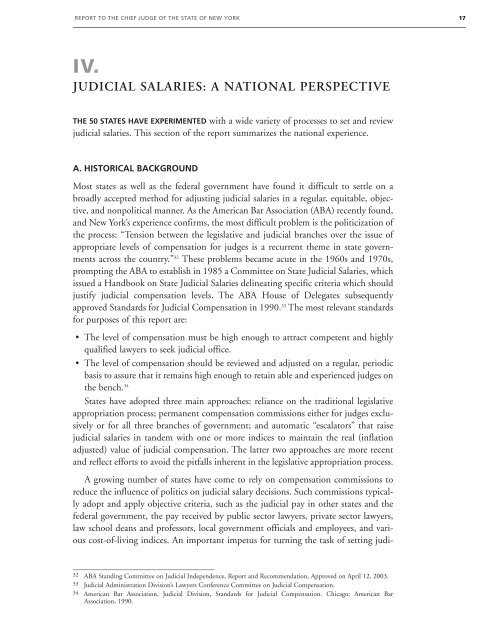Judicial Compensation in New York: A National Perspective, Report
Judicial Compensation in New York: A National Perspective, Report
Judicial Compensation in New York: A National Perspective, Report
Create successful ePaper yourself
Turn your PDF publications into a flip-book with our unique Google optimized e-Paper software.
REPORT TO THE CHIEF JUDGE OF THE STATE OF NEW YORK 17<br />
IV.<br />
JUDICIAL SALARIES: A NATIONAL PERSPECTIVE<br />
THE 50 STATES HAVE EXPERIMENTED with a wide variety of processes to set and review<br />
judicial salaries. This section of the report summarizes the national experience.<br />
A. HISTORICAL BACKGROUND<br />
Most states as well as the federal government have found it difficult to settle on a<br />
broadly accepted method for adjust<strong>in</strong>g judicial salaries <strong>in</strong> a regular, equitable, objective,<br />
and nonpolitical manner. As the American Bar Association (ABA) recently found,<br />
and <strong>New</strong> <strong>York</strong>’s experience confirms, the most difficult problem is the politicization of<br />
the process: “Tension between the legislative and judicial branches over the issue of<br />
appropriate levels of compensation for judges is a recurrent theme <strong>in</strong> state governments<br />
across the country.” 32 These problems became acute <strong>in</strong> the 1960s and 1970s,<br />
prompt<strong>in</strong>g the ABA to establish <strong>in</strong> 1985 a Committee on State <strong>Judicial</strong> Salaries, which<br />
issued a Handbook on State <strong>Judicial</strong> Salaries del<strong>in</strong>eat<strong>in</strong>g specific criteria which should<br />
justify judicial compensation levels. The ABA House of Delegates subsequently<br />
approved Standards for <strong>Judicial</strong> <strong>Compensation</strong> <strong>in</strong> 1990. 33 The most relevant standards<br />
for purposes of this report are:<br />
• The level of compensation must be high enough to attract competent and highly<br />
qualified lawyers to seek judicial office.<br />
• The level of compensation should be reviewed and adjusted on a regular, periodic<br />
basis to assure that it rema<strong>in</strong>s high enough to reta<strong>in</strong> able and experienced judges on<br />
the bench. 34<br />
States have adopted three ma<strong>in</strong> approaches: reliance on the traditional legislative<br />
appropriation process; permanent compensation commissions either for judges exclusively<br />
or for all three branches of government; and automatic “escalators” that raise<br />
judicial salaries <strong>in</strong> tandem with one or more <strong>in</strong>dices to ma<strong>in</strong>ta<strong>in</strong> the real (<strong>in</strong>flation<br />
adjusted) value of judicial compensation. The latter two approaches are more recent<br />
and reflect efforts to avoid the pitfalls <strong>in</strong>herent <strong>in</strong> the legislative appropriation process.<br />
A grow<strong>in</strong>g number of states have come to rely on compensation commissions to<br />
reduce the <strong>in</strong>fluence of politics on judicial salary decisions. Such commissions typically<br />
adopt and apply objective criteria, such as the judicial pay <strong>in</strong> other states and the<br />
federal government, the pay received by public sector lawyers, private sector lawyers,<br />
law school deans and professors, local government officials and employees, and various<br />
cost-of-liv<strong>in</strong>g <strong>in</strong>dices. An important impetus for turn<strong>in</strong>g the task of sett<strong>in</strong>g judi-<br />
32 ABA Stand<strong>in</strong>g Committee on <strong>Judicial</strong> Independence, <strong>Report</strong> and Recommendation, Approved on April 12, 2003.<br />
33 <strong>Judicial</strong> Adm<strong>in</strong>istration Division’s Lawyers Conference Committee on <strong>Judicial</strong> <strong>Compensation</strong>.<br />
34 American Bar Association, <strong>Judicial</strong> Division, Standards for <strong>Judicial</strong> <strong>Compensation</strong>. Chicago: American Bar<br />
Association, 1990.
















